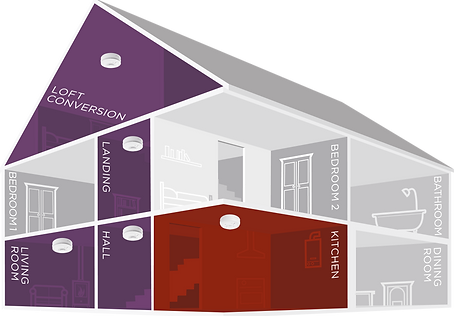
Domestic
Smoke & fire detection
Do you require a fire/smoke alarm system installed within a domestic property? If so AJS & Sons can Install the system you need.
There are two important factors to consider when choosing a domestic fire/smoke alarm system, they are the category & grade of system.

HMO (house of multiple occupation)
For HMO`s with 3 stories or more, a category LD2 grade A system is likely most suitable. This type of system generally has a central control panel with a dedicated mains supply, and a 72 hour battery back up. detectors will be sited in fire escape routes such as in hallways and on landings, with the addition of heat detectors in areas of high risk i.e kitchens. Alarm sounders can either be incorporated with the detectors or separate.
Categories for domestic fire detection and fire alarm systems (as per BS 5839-6-:2019) :
With regard to categories, the standard of protection in sheltered housing flats has been increased from Category LD2 to Category LD1, positioning it as a higher potential risk. To meet LD1 requirements, the installation of a fire detection system is required throughout the premises - this includes all rooms (and circulation areas that form part of the escape routes) except toilets, bathrooms and shower rooms.
The three categories for fire detection and fire alarm systems are listed below and outline where fire detection systems should be installed:
LD1 Maximum Protection
Escape routes, high risk rooms plus all areas where a fire might start
Escape routes, high risk rooms plus all areas where a fire might start
Category LD1: The highest level of protection of all occupants who might occupy the dwelling over the lifetime of the fire detection and fire alarm system. A system installed throughout the premises, incorporating detectors in all circulation areas that form part of the escape routes from the premises, and in all rooms and areas, other than those with negligible sources of ignition, such as toilets, bathrooms and shower rooms.
• Hallway
• Landing
• Living Room
• Kitchen (Heat alarm)
• Bedroom
• Airing / Meter Cupboards
• Loft
• Garage
LD2 Medium Protection
Escape routes plus high risk rooms
Escape routes plus high risk rooms
Category LD2: A system incorporating detectors in all circulation areas that form part of the escape routes from the premises, and in all specified rooms or areas that present a high fire risk to occupants, including any kitchen and the principal habitable room.
• Hallway
• Landing
• Living Room
• Kitchen (Heat alarm)
LD3 Minimum Protection
Escape routes only
Escape routes only
Category LD3: A system incorporating detectors in all circulation areas that form part of the escape routes from the premises.
• Hallway
• Landing
Note: This minimum category now only applies to owner occupied bungalow, flat, single-storey unit or maisonette with no floor level above 4.5m from ground level or owner-occupied two-storey house.



2019 system grading for fire detection and fire alarm systems:
Whilst BS 5839-6 has previously been split into six varying Grades, each outlining the level of protection appropriate for certain properties and their corresponding levels of risk, the new update has altered the six sections, removing Grade B and Grade E, whilst Grade D and Grade F have been split into Grade D1 / Grade D2 and Grade F1 / Grade F2 respectively. Grade C has been revised and its recommendations expanded.
The new grading system is as follows:
Grade A
Separate detectors, sounders and central control and indicating equipment with back-up power supply that conforms to British Standards BS EN 54.
Grade C
A system consisting of fire detectors and alarm sounders (which may be domestic smoke alarms) connected to a common power supply, comprising normal mains and stand-by supply, with central control equipment.
Grade D1
A system of one or more mains powered detectors, each with a tamper‑proof standby supply consisting of a battery or batteries (such as Aico Ei166e).
Grade D2
A system of one or more mains-powered detectors, each with an integral standby supply consisting of a user‑replaceable battery or batteries. (such as Aico Ei186).
Grade F1
A system of one or more battery-powered detectors powered by a tamper‑proof primary battery or batteries (such as FireAngel’s ST-622, ST-750 alarm).
Grade F2
A system of one or more battery-powered detectors powered by a user‑replaceable primary battery or batteries. (such as FireAngel’s SB1-T alarm).
Grades B and E are no longer defined in BS 5839-6:2019.



Get in contact today
Local electrician based in Gillingham Medway Kent.

Approved & registered electrician serving
Gillingham, Chatham, Rainham, Rochester, Strood, Frindsbury, Brompton, Walderslade, Wigmore, Cuxton, Halling, Wouldham, Hoo, St Werburgh, Cliffe, High Halstow, St Mary Hoo, Allhallows, Stoke and Grain.
As well as the wider kent area.
